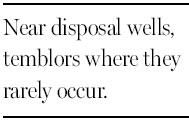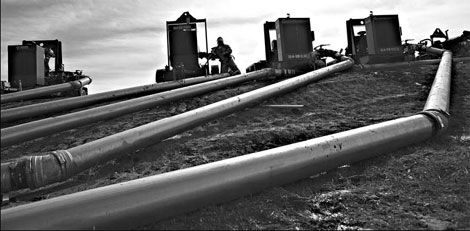Quakes increase drilling concerns
Updated: 2012-01-15 08:08
By Henry Fountain (The New York Times)
|
||||||||
|
Scientists are trying to determine if "fracking" to extract oil can cause serious tremors. Brandon Thibodeaux for The New York Times |
YOUNGSTOWN, Ohio - Until last year, this city and the surrounding county had been seismically dead since Scots-Irish settlers arrived in the 18th century.
But on March 17, two minor earthquakes shook the city. And since then there have been nine more - most too weak to cause damage. The latest, on December 31, had a magnitude of 4.0, severe enough to cause minor damage.
Eleven quakes in nine months in a seismically inactive area is unusual. But seismologists found another surprise: most of the quakes' epicenters coincided with the location of a 2,750-meter well.
At the well, a local company has been disposing of liquids from natural gas wells - millions of liters of waste from hydraulic fracturing, a process used to unlock the gas from shale rock.
The location and timing of the quakes led to suspicions that the disposal well was responsible. As wastewater was injected into the well under pressure, the thinking went, some of it might have migrated into deeper rock formations, unclamping ancient faults.
More than 30 countries are now considering hydraulic fracturing, or fracking. But the practice has come under fire for its potential to pollute the air and contaminate drinking water. And the tremors in Youngstown and other shale-gas-producing areas raise the notion that the technique could lead to a damaging quake.
Scientists say the likelihood of that link is remote, and that the wells' relatively shallow depths mean any quakes that are triggered would be minor. "But still, you don't want it to happen," said Mark Zoback, a geophysicist at Stanford University.

Among the thousands of small quakes in Arkansas since 2010 that were thought to be linked to disposal wells was one of magnitude 4.7, and a disposal well in Colorado was tied to numerous quakes in the 1960s, including several of magnitude 5.0 or higher. Deeper geothermal wells have also caused damaging quakes.
Officials with D & L Energy, the Youngstown company that has been disposing of the waste, and with the Ohio government say there is no proof of a link between the well and the earthquakes. But the state has asked the company to plug the bottom of the well.
Researchers from the Lamont-Doherty Earth Observatory in New York have installed four seismometers near the well. If more earthquakes occur, "It should help us make the case one way or another," said John Armbruster, a Lamont seismologist.
C. Jeffrey Eshelman, a spokesman for the Independent Petroleum Association of America, said that "it has been impossible to determine whether hydraulic fracturing has anything to do with" the quakes, adding, "Although they are minor incidents, they are still something to be taken seriously."
Scientists say it is known that wells can induce quakes, but it can be difficult to prove a connection. In July, Arkansas ordered that one well be shut down, and it placed a moratorium on new ones. Three other disposal wells closed voluntarily. While small earthquakes are still occurring in the area, their frequency has declined substantially.
In northwestern England, a report concluded that two quakes of magnitude 1.5 and 2.3 near Blackpool last spring were related to a fracking well. In Oklahoma, a seismologist concluded there was a "possibility" that a series of small quakes in January 2011 were induced by a nearby fracking operation.
Fracking is known to cause slight tremors when the fluid is injected into shale. But the larger quakes near Blackpool were thought to be caused the same way that quakes could be set off from disposal wells - by migration of the fluid into rock below the shale. Seismologists say that faults in these deeper, older rocks, referred to as the "basement," have reached equilibrium over hundreds of millions of years.
"No matter where you drill," said Leonardo Seeber, a Lamont seismologist, "the basement is going to have faults that could rupture."
The New York Times

 Relief reaches isolated village
Relief reaches isolated village
 Rainfall poses new threats to quake-hit region
Rainfall poses new threats to quake-hit region
 Funerals begin for Boston bombing victims
Funerals begin for Boston bombing victims
 Quake takeaway from China's Air Force
Quake takeaway from China's Air Force
 Obama celebrates young inventors at science fair
Obama celebrates young inventors at science fair
 Earth Day marked around the world
Earth Day marked around the world
 Volunteer team helping students find sense of normalcy
Volunteer team helping students find sense of normalcy
 Ethnic groups quick to join rescue efforts
Ethnic groups quick to join rescue efforts
Most Viewed
Editor's Picks

|

|

|

|

|

|
Today's Top News
Health new priority for quake zone
Xi meets US top military officer
Japan's boats driven out of Diaoyu
China mulls online shopping legislation
Bird flu death toll rises to 22
Putin appoints new ambassador to China
Japanese ships blocked from Diaoyu Islands
Inspired by Guan, more Chinese pick up golf
US Weekly

|

|







